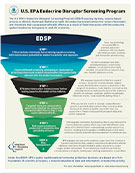July 26, 2016
Comments Submitted to the EU Commission on Proposed Criteria for Identifying EDCs
Points 3.6.5.2 and 3.8.2 in ANNEX 1 of the Draft Regulation propose three criteria for a substance to be considered an endocrine disrupting chemical (EDC): 1) it causes an adverse effect relevant to human health, 2) it has an endocrine mode of action and 3) there is a causal link between the adverse effect and the endocrine mode of action. These would be appropriate standards of evidence to identify EDCs if criterion 2 is modified to include potency, as explained below. Lower standards, proposed by some commenters, would make it impossible to distinguish real from imagined endocrine risks, leading to inaccurate decision-making more likely to harm than protect human and environmental health, and would necessitate a process for correcting mistakes similar to the Human Relevance/Key Events Dose Response Framework now used to rectify the many irrelevant carcinogen classifications that were made based on the low evidentiary standard used in that program. The EC’s program for EDCs should adopt a scientific approach rather than replicate weaknesses of the antiquated carcinogen classification scheme.
Omitting potency did not create a more relevant standard of evidence as argued in the German Federal Institute consensus statement. Potency is the strength of a chemical’s interaction with the endocrine system; toxicity refers to its strength in producing adverse effects. High potency allows the endocrine system to distinguish hormones that convey critical biological signals from the numerous other chemicals occurring naturally in the body that interact with it inconsequentially, having insufficient potency to produce endocrine effects. High potency also distinguishes exogenous chemicals that can mimic hormones or interfere with their action from low potency chemicals that merely interact with the endocrine system without altering its function. For example, low potency is the reason that essential fatty acids and most phenols found naturally in fruits and vegetables lack estrogenic effects even though they interact with estrogen receptors. Potency evaluation is so powerful and reliable that it is the pharmaceutical industry’s chief means of identifying hormonally active drug candidates and excluding low potency chemicals with no potential to produce endocrine effects. Thus, potency is the basic operating principle of the endocrine system that provides the critical link between an endocrine mode of action and an adverse effect.
Some argue that the proposed criteria will fail to identify EDCs because evidence for a causal link between an endocrine mode of action and adverse effects in humans is unattainable. That link will be difficult to make only because the proposed criteria relegate potency to a post-hoc role in dose-response characterization, thus eliminating the most efficient way to reliably identify EDCs. Instead, the evaluation of potency is necessary in the identification phase because it provides the necessary link between adverse effects and an endocrine mode of action. To solve this problem, please modify Criterion 2: “(2) it acts through an endocrine mode of action with sufficient potency to alter human endocrine function, as established by potency comparisons to human hormones or human pharmaceuticals.” This would reliably identify EDCs without direct human data or extensive animal testing on each chemical.
The draft regulation and Annex II emphasizes consideration of data from internationally agreed study protocols, appropriately. The open literature is also useful, but mostly for potency data from established methods rather than for newly-proposed adverse endocrine responses. Although novel observations may eventually become validated, regulations must be based on currently established scientific evidence. The credibility of most novel observations is short-lived, and although such data could be considered in identifying EDCs, their proper context and unvalidated status must be acknowledged and weighed accordingly.



